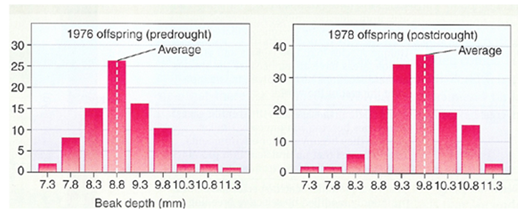Peter and Rosemary Grant study natural selection in finches on the Galápagos Islands. They have hypothesized that dry condition produce larger seeds and may result in larger beaks in succeeding generations of finches. The figure below shows their data from 1976 and 1978. The y-axis is the number of birds measured and the x-axis is the beak depth. Do their data support their hypothesis and why?

A. Yes; because there were more birds measured in 1978 after the drought, therefore they must have been able to get food and reproduce.
B. Yes; because the average beak depth of birds in the population increased from 8.8mm in 1976 to 9.8mm in 1978.
C. No; because even though more birds were measured in 1978, the beak size of the upper range was smaller.
D. No; because in 1976, before the drought, the largest beak depth was still 11.3mm.
E. No; more data would be necessary to show a support of their hypothesis.
B. Yes; because the average beak depth of birds in the population increased from 8.8mm in 1976 to 9.8mm in 1978.
You might also like to view...
Isolating a bacterium of the ________ class would be of high impact due to it only having one cultured representative
A) Alphaproteobacteria B) Betaproteobacteria C) Epsilonproteobacteria D) Zetaproteobacteria
Ways to Inhibit QS
What will be an ideal response?
In the three domain system of classification,
A. eukaryotes are more similar to the prokaryotes now classified into domain Bacteria than to those now classified into domain Archaea. B. animals and plants are less similar to each other than to the prokaryotes now classified into domain Archaea. C. prokaryotes are classified into two domains, with the organisms in domain Archaea more similar to eukaryotes than to the prokaryotes in the domain Bacteria. D. cladistics alone were used to formulate the new phylogenetic tree of life. E. by the principle of parsimony, it required fewer assumptions to divide the prokaryotes into two domains than it did to put them into a single domain.
Which of the following fully explains the concept of humanity's ecological footprint?
A. the total amount of land and water required to support the occupation, consumption, and waste production of the global population B. the amount of land occupied by people, buildings, and structures C. the amount of energy and water used in household consumption D. the amount of land needed to feed the global population E. the amount of land required to support the consumption and waste production of the global population